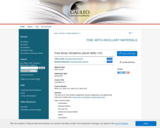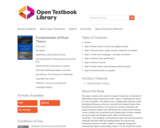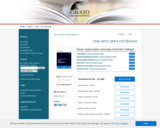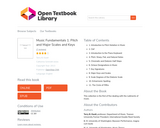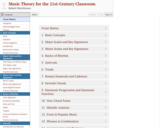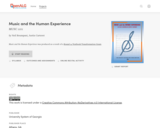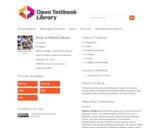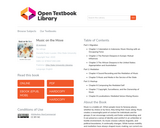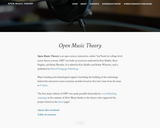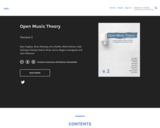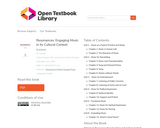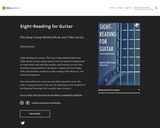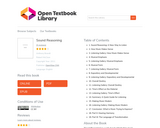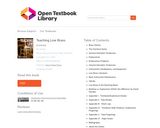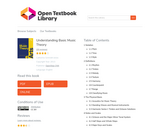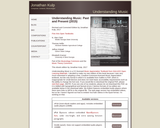Open Music Theory is an open-source, interactive, online “text”book for college-level music theory courses. OMT was built on resources authored by Kris Shaffer, Bryn Hughes, and Brian Moseley. It is edited by Kris Shaffer and Robin Wharton, and is published by Hybrid Pedagogy Publishing.
Table of Contents
Fundamentals
Basic notation.
Meter.
Protonotation.
Rhythmic values.
Beams and borrowed divisions.
Pitches.
Scales and scale degrees.
Key signatures.
Intervals.
Triads and seventh chords.
Types of motion.
Voice-leading and model composition
Introduction to strict voice-leading.
Strict two-voice composition (species counterpoint)
Composing a cantus firmus.
Composing a first-species counterpoint.
Composing a second-species counterpoint.
Composing a third-species counterpoint.
Composing a fourth-species counterpoint.
Strict four-voice composition
Introduction to thoroughbass.
A brief history of basso continuo.
Generating Roman numerals from a figured bass line.
Composing in basso-continuo style.
Style and tendency.
Tendency tones and functional harmonic dissonances.
Realizing a figured bass in strict basso continuo style (video).
Melodic keyboard style voice-leading.
Melodic keyboard-style voice-leading schemata.
Realizing a figured bass line in melodic keyboard style (video).
Realizing an unfigured bass line (video).
Embellishing tones.
Harmony
Introduction to musical functions.
Harmonic functions.
Harmonic syntax - the idealized phrase.
Harmonic syntax - prolongation.
Performing a harmonic analysis.
Classical cadence types.
Chromatically altered subdominant chords.
Applied chords.
Modal mixture.
Modulation.
Handouts and charts
Lead-sheet and figured-bass symbols.
Harmonies (Roman numerals and functional bass) by bass scale degree.
Form
Thematic Structure in the Classical Style
Classical theme types.
The sentence.
The period.
Hybrid themes.
Compound periods.
Compound sentences.
The small ternary.
The small binary.
Theme type reference.
Thematic function reference.
Techniques of Phrase Rhythm
External Expansions.
Internal Expansions.
Sonata Form
Introduction to Sonata Theory.
Sonata form: exposition types.
Structural Points of Arrival.
Thematic Modules.
Sonata form: the recapitulation.
Sonata form: the development.
Sonata form: framing modules (intro & coda).
Rondo Form
Introduction to Rondo form.
Thematic Function in Rondo Form.
Five-Part Rondo.
Sonata Rondo.
Other formal structures in the classical style
Minuet form.
Galant Schemata
Galant schemata – opens and closes.
Galant Schemata – continuation patterns.
Galant schemata – summary.
Improvising a sentence with galant schemata.
Post-tonal music
Basics
Pitch (class).
Interval (class).
Modular 12 arithmetic.
Organizing Forces
Collections and Scales.
Symmetry and Centricity.
Set Theory
Pitch-Class Sets.
Normal Order.
Tranposition.
Inversion.
Set Class and Prime Form (1).
Set Class and Prime Form (2).
Complements.
Common Tones under Transposition.
Common Tones under Inversion.
Tranpositional Symmetry.
Twelve-Tone Theory
Basics.
Operations.
Intervallic Structure.
Derivation.
Invariance.
General post-tonal resources
Analyzing a post-tonal piece from scratch.
Analyzing atonal music.
Analyzing 12-tone music.
Glossary of atonal musical terms.
Sheet of blank chromatic-scale clock faces.
Pop/rock music
Rhythm
Syncopation in pop/rock music.
Harmony
Harmony in pop/rock music.
The “50s doo-wop” progression.
The “Singer/Songwriter” progression.
The “Puff” progression.
The blues progression.
The lament progression.
The circle-of-fifths progression (in minor)
Plagal progressions.
Form
Form in pop/rock music – overview.
Terminology and basic concepts.
Formal containers and module structures.
Formal functions.
Analytical notation.
Text and music
Analyzing poetry.
